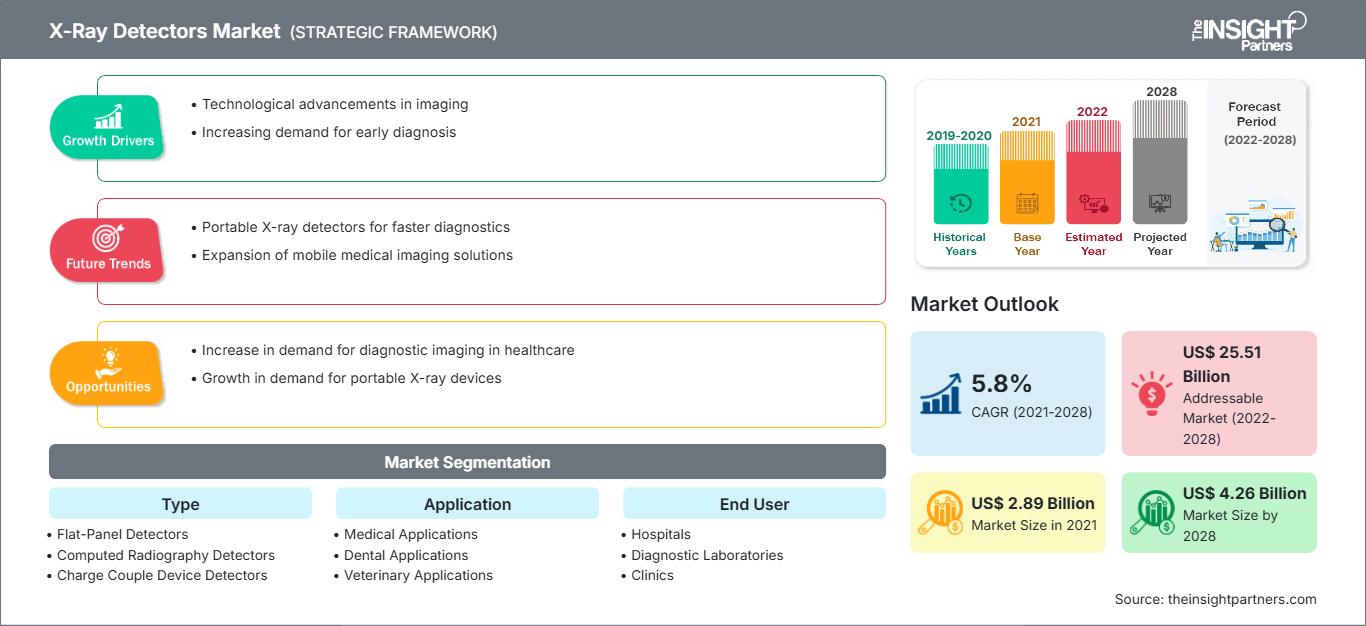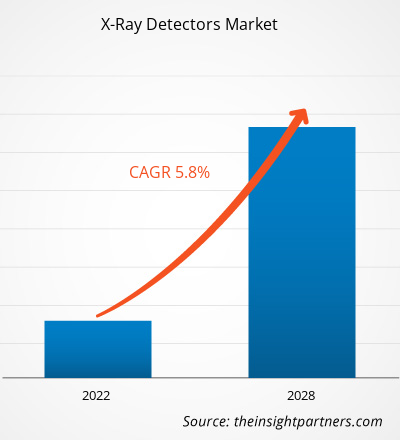[Rapporto di ricerca]Si prevede che il mercato dei rilevatori di raggi X raggiungerà circa 4.256,75 milioni di dollari entro il 2028; si prevede una crescita a un CAGR del 5,8% dal 2022 al 2028.
I rilevatori di raggi X sono dispositivi utilizzati per misurare il flusso, la distribuzione spaziale, lo spettro e/o altre proprietà dei raggi X. In ambito sanitario, i rilevatori di raggi X sono comunemente utilizzati in applicazioni mediche per vari scopi diagnostici. Il design del rilevatore di raggi X varia in termini di dimensioni, forma, risoluzione spaziale, frame rate e flusso di raggi X, tra gli altri, per soddisfare i requisiti applicativi.
Il mercato dei rilevatori di raggi X è segmentato in base a tipologia, applicazione, utente finale e area geografica. Per area geografica, il mercato è ampiamente segmentato in Nord America, Europa, Asia-Pacifico, Medio Oriente e Africa e Sud e Centro America. Questo rapporto offre approfondimenti e analisi approfondite del mercato, sottolineando parametri quali tendenze e dinamiche di mercato, insieme all'analisi competitiva dei principali attori del mercato a livello mondiale.
Personalizza questo rapporto in base alle tue esigenze
Potrai personalizzare gratuitamente qualsiasi rapporto, comprese parti di questo rapporto, o analisi a livello di paese, pacchetto dati Excel, oltre a usufruire di grandi offerte e sconti per start-up e università
Mercato dei rilevatori di raggi X: Approfondimenti strategici

-
Ottieni le principali tendenze chiave del mercato di questo rapporto.Questo campione GRATUITO includerà l'analisi dei dati, che vanno dalle tendenze di mercato alle stime e alle previsioni.
Approfondimenti di mercato
I principali fattori che guidano la crescita del mercato includono l'aumento dell'incidenza e della prevalenza di disturbi cronici, nonché il lancio e l'approvazione di nuovi prodotti.
Disturbi cronici come quelli cardiovascolari, respiratori e ortopedici, così come vari tipi di cancro, stanno causando disabilità e mortalità in tutto il mondo. Queste condizioni cliniche influiscono sulla qualità della vita complessiva. Secondo l'Organizzazione Mondiale della Sanità (OMS), si stima che oltre il 50% della popolazione mondiale soffra di almeno una malattia cronica. I Centri per il Controllo e la Prevenzione delle Malattie (CDC) hanno dichiarato che 6 persone su 10 negli Stati Uniti soffrivano di almeno una malattia cronica nel 2019. Le malattie cardiovascolari (CVD) dovute a uno stile di vita frenetico sono una causa significativa di mortalità a livello globale. I disturbi ortopedici sono tra le principali cause di anni di vita persi per disabilità (DALY) osservati nella vasta popolazione geriatrica a livello globale. Secondo l'articolo pubblicato da SingleCare, nel 2021 oltre 350 milioni di persone in tutto il mondo convivevano con l'artrite. Paesi come Stati Uniti, Giappone, Corea del Sud, Canada, Regno Unito, Spagna e Francia stanno assistendo a una crescita sostanziale della popolazione geriatrica. Queste economie, insieme a Cina, India, Arabia Saudita, Emirati Arabi Uniti e Brasile, offrono significative opportunità di crescita per l'introduzione di dispositivi innovativi nel mercato globale dei rilevatori di raggi X.
Di seguito sono elencati alcuni esempi di sviluppi che hanno promosso la crescita del mercato dei rilevatori di raggi X:
- Nell'ottobre 2022, Rigaku Corporation, produttore leader di apparecchiature per l'analisi e l'ispezione a raggi X, ha lanciato sul mercato globale il suo nuovo rilevatore XSPA-400 ER (X-ray Seamless Pixel Array) dopo il successo del lancio nazionale al JASIS (Japan Analytical and Scientific Instruments Show) nel settembre 2022. L'XSPA-400 ER è un rilevatore multidimensionale a pixel continui per diffrattometri a raggi X con elevata risoluzione energetica, adatto all'analisi di batterie, acciaio e ceramica.
- Nell'agosto 2021, Rigaku Corporation ha acquisito tutte le azioni emesse di MILabs BV il 2 agosto 2021, nell'ambito del suo impegno su vasta scala per entrare nel settore delle scienze della vita. Attraverso questa acquisizione, Rigaku espanderà la sua attività nel settore delle scienze della vita a livello globale, combinando MILabs con Attività multimodali, tra cui tomografia a emissione di positroni (PET), tomografia computerizzata a emissione di fotone singolo (SPECT), imaging ottico e apparecchiature per tomografia computerizzata (TC) per animali, con l'attività originale di Rigaku dedicata all'imaging a raggi X per animali.
- A settembre 2021, Canon ha acquisito Redlen. Questa acquisizione aiuterà Canon a ottenere una tecnologia avanzata di rilevamento e imaging delle radiazioni utilizzata nei moduli rivelatori a semiconduttore CZT, che svolgono un ruolo importante nello sviluppo della TC a conteggio di fotoni (PCCT). Ciò consentirà a Canon Medical Systems Corporation, anch'essa una sussidiaria di Canon, di accelerare lo sviluppo di sistemi PCCT competitivi per rafforzare il business dei sistemi medicali.
Approfondimenti sui prodotti
In base alla tipologia, il mercato dei rivelatori a raggi X è segmentato in rivelatori per radiografia computerizzata (CR), rivelatori a pannello piatto, rivelatori a scansione lineare e rivelatori a dispositivo di accoppiamento di carica (CCD). Il segmento dei rivelatori a pannello piatto ha detenuto la quota maggiore del mercato nel 2021 e si prevede che registrerà il CAGR più elevato durante il periodo di previsione. I sistemi a raggi X utilizzano spesso rivelatori a pannello piatto indiretti per la conversione dell'energia dei raggi X in energia luminosa, utilizzata per generare immagini di ispezione a raggi X. I rivelatori a pannello piatto vengono utilizzati anche nella radiografia digitale per convertire i raggi X in carica (conversione diretta), che viene poi interpretata utilizzando una matrice di transistor a film sottile.
Approfondimenti regionali sul mercato dei rilevatori di raggi X
Le tendenze regionali e i fattori che influenzano il mercato dei rilevatori di raggi X durante il periodo di previsione sono stati ampiamente spiegati dagli analisti di The Insight Partners. Questa sezione illustra anche i segmenti e la geografia del mercato dei rilevatori di raggi X in Nord America, Europa, Asia-Pacifico, Medio Oriente e Africa, America Meridionale e Centrale.
Ambito del rapporto di mercato sui rilevatori di raggi X
| Attributo del rapporto | Dettagli |
|---|---|
| Dimensioni del mercato in 2021 | US$ 2.89 Billion |
| Dimensioni del mercato per 2028 | US$ 4.26 Billion |
| CAGR globale (2021 - 2028) | 5.8% |
| Dati storici | 2019-2020 |
| Periodo di previsione | 2022-2028 |
| Segmenti coperti |
By Tipo
|
| Regioni e paesi coperti |
Nord America
|
| Leader di mercato e profili aziendali chiave |
|
Densità degli operatori del mercato dei rilevatori di raggi X: comprendere il suo impatto sulle dinamiche aziendali
Il mercato dei rilevatori di raggi X è in rapida crescita, trainato dalla crescente domanda degli utenti finali, dovuta a fattori quali l'evoluzione delle preferenze dei consumatori, i progressi tecnologici e una maggiore consapevolezza dei vantaggi del prodotto. Con l'aumento della domanda, le aziende stanno ampliando la propria offerta, innovando per soddisfare le esigenze dei consumatori e sfruttando le tendenze emergenti, alimentando ulteriormente la crescita del mercato.

- Ottieni il Mercato dei rilevatori di raggi X Panoramica dei principali attori chiave
Rilevatori a raggi X - Segmentazione del mercato
Il mercato dei rilevatori a raggi X è segmentato in base a tipologia, applicazione, utente finale e area geografica. In base alla tipologia, il mercato è suddiviso in rilevatori di radiografia computerizzata (CR), rilevatori a schermo piatto, rilevatori a scansione lineare e rilevatori a dispositivo di accoppiamento di carica (CCD). In base all'applicazione, il mercato dei rilevatori a raggi X è suddiviso in applicazioni mediche, odontoiatriche, veterinarie e di altro tipo. In termini di utente finale, il mercato dei rilevatori a raggi X è segmentato in ospedali, laboratori diagnostici, cliniche e altri utenti finali. In base all'area geografica, il mercato dei rilevatori a raggi X è segmentato in Nord America (Stati Uniti, Canada e Messico), Europa (Regno Unito, Germania, Francia, Italia, Spagna e resto d'Europa), Asia-Pacifico (Cina, Giappone, India, Australia, Corea del Sud e resto dell'Asia-Pacifico), Medio Oriente e Africa. Africa (Emirati Arabi Uniti, Arabia Saudita, Africa e resto del Medio Oriente e dell'Africa) e America meridionale e centrale (Brasile, Argentina e resto dell'America meridionale e centrale).
Profili aziendali
- PerkinElmer Inc
- Varian Medical Systems Inc
- FUJIFILM Holdings Corp
- Teledyne Technologies Inc
- Analogic Corp
- Konica Minolta Inc
- Canon Inc
- Varex Imaging Corp
- Rigaku Corp
- Moxtek Inc
- Analisi storica (2 anni), anno base, previsione (7 anni) con CAGR
- Analisi PEST e SWOT
- Valore/volume delle dimensioni del mercato - Globale, Regionale, Nazionale
- Industria e panorama competitivo
- Set di dati Excel
Report recenti
Rapporti correlati
Testimonianze
Motivo dell'acquisto
- Processo decisionale informato
- Comprensione delle dinamiche di mercato
- Analisi competitiva
- Analisi dei clienti
- Previsioni di mercato
- Mitigazione del rischio
- Pianificazione strategica
- Giustificazione degli investimenti
- Identificazione dei mercati emergenti
- Miglioramento delle strategie di marketing
- Aumento dell'efficienza operativa
- Allineamento alle tendenze normative






















 Ottieni un campione gratuito per - Mercato dei rilevatori di raggi X
Ottieni un campione gratuito per - Mercato dei rilevatori di raggi X